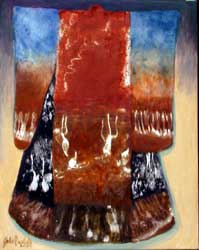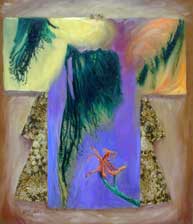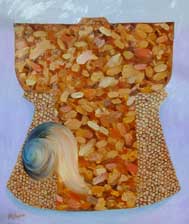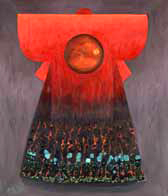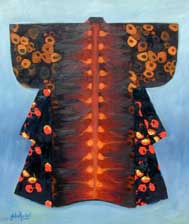

 View Portfolio |
 Inside Time |
 Shows |
 About/Contact the Artist |
The Senses and the Japanese Tea Ceremony.After much work on the various senses, this series sums up all of them in a single gesture. Each Kimono in the series has been designed based on one of the five senses - five in all. They will start as paintings, and eventually will be made into Kimonos.
See portfolio for more paintings on the senses.
"A Taste of Japan; Taste Bud Kimono for a Japanese Tea Ceremony", 16" x 20"(left); Japanese Tea Ceremony with Taste Bud Kimono", 16" x 20" (right).
Oil and mixed media (left) and Oil on Canvas (right).
Large final version of Kimono is 36" x 42", $3000
These are small, prototype paintings. Ther is also a larger, 36" x 42" versions of the kimono, $5,300 framed
As the Japanese Tea Ceremony emphasizes the use of all the senses, there will be a Kimono designed for each taste, using imagery of the types of cells and receptors involved in that particular taste.
Taste bud images courtesy of Bernd Lindemann, University of Saarlandes, from the paper "Multi-photon microscopy of cell types in the viable taste disk of the frog", Jack H.-Y. Li · Bernd Lindemann, Cell Tissue Res (2003) 313:11–27.
Specialt hanks to the Urasenke Foundation for offering the Japanese Tea Ceremony experience in San Francisco.
"Kimono for the Sense of Smell"
36" x 42", oil on canvas, $3,000 framedInspired in part by article and images in "Visualizing an Olfactory Sensory Map", by Mombaerts P, Wang F, Dulac C, Chao SK, Nemes A, Mendelsohn M, Edmondson J, Axel R., Cell. 1996 Nov 15;87(4):675-86, and the review "The Molecular Logic of Smell", by Axel R., Sci Am. 1995 Oct;273(4):154-9; and images by Dr. Richard Costanzo of Virginia Commonwealth University -olfactory neuron "flower" image and panels.
"Kimono for the Sense of Hearing"
36" x 42", oil on canvas, $3,000 framed.Side panels are view of hair cells inside an ear from the top, courtesy of Dr. James O. Pickles, University of Queensland. Spiral structure is a human cochlea, and the background patterns are human otoliths from http://paperairplane.mit.edu/16.423J/Space/SBE/neurovestibular/
NeuroVestibular/2_Physiology/PhysSub2.html. More specific credits being researched for these two items.
"Kimono for the Sense of Sight"
36" x 42", oil on canvas, $3,000 framed.
"Kimono for the Sense of touch"
36" x 42", oil on canvas, $3,000 framed.Back panel and sleve images from Jason Meyers and David Corey, Harvard Medical School, from the paper "Lighting up the senses: FM1-43 loading of sensory cells through nonselective ion channels", J Neurosci. 2003 May 15;23(10):4054-65. Side panels are of Merkel Cells and Neurons, courtesy of Dr. Michael Welsh, University of Iowa. .
